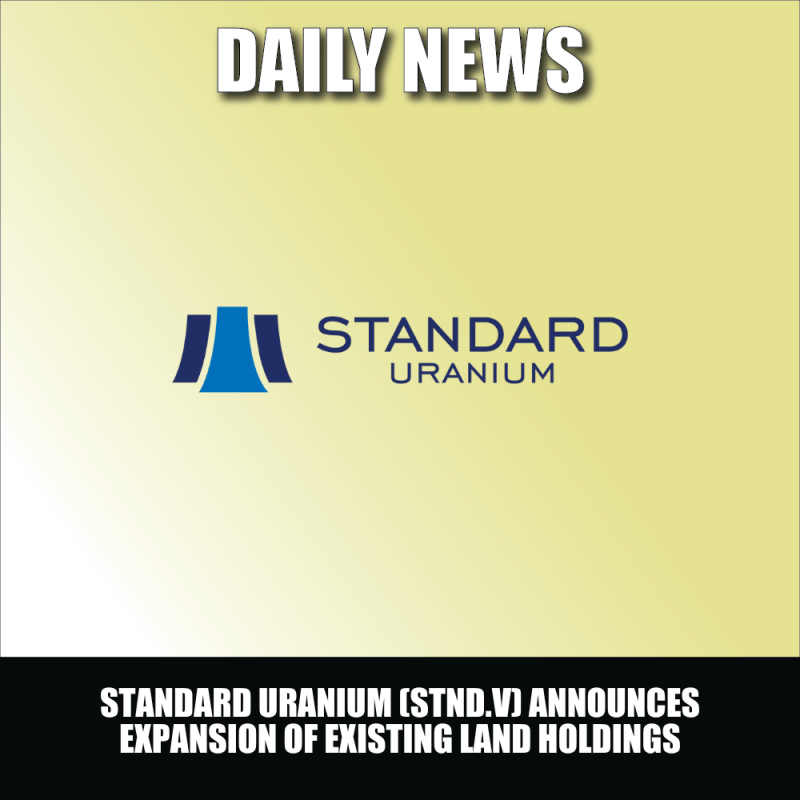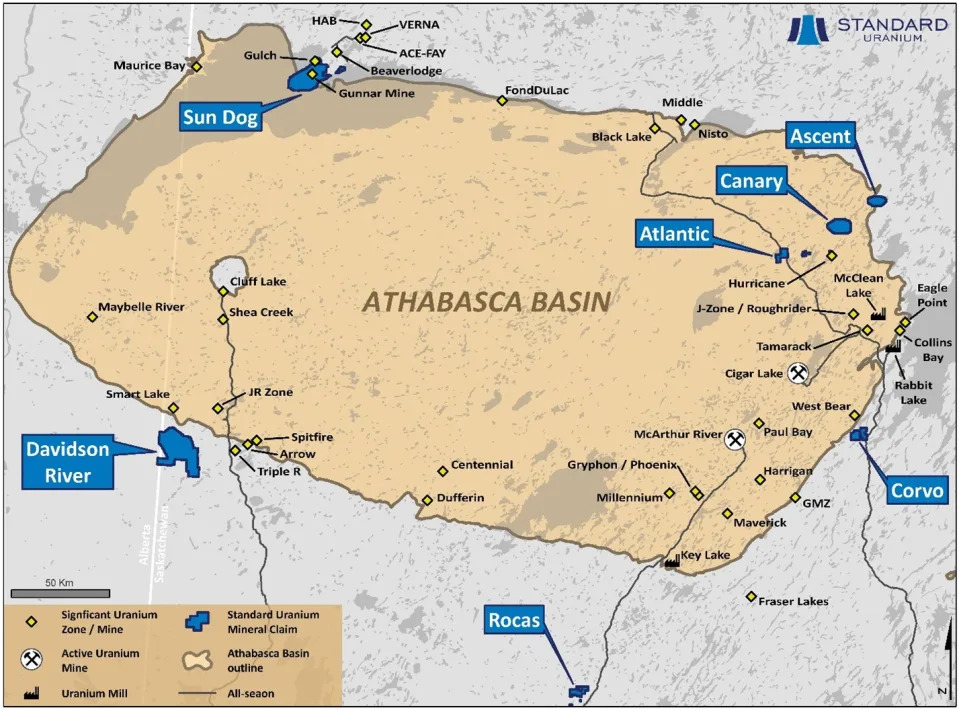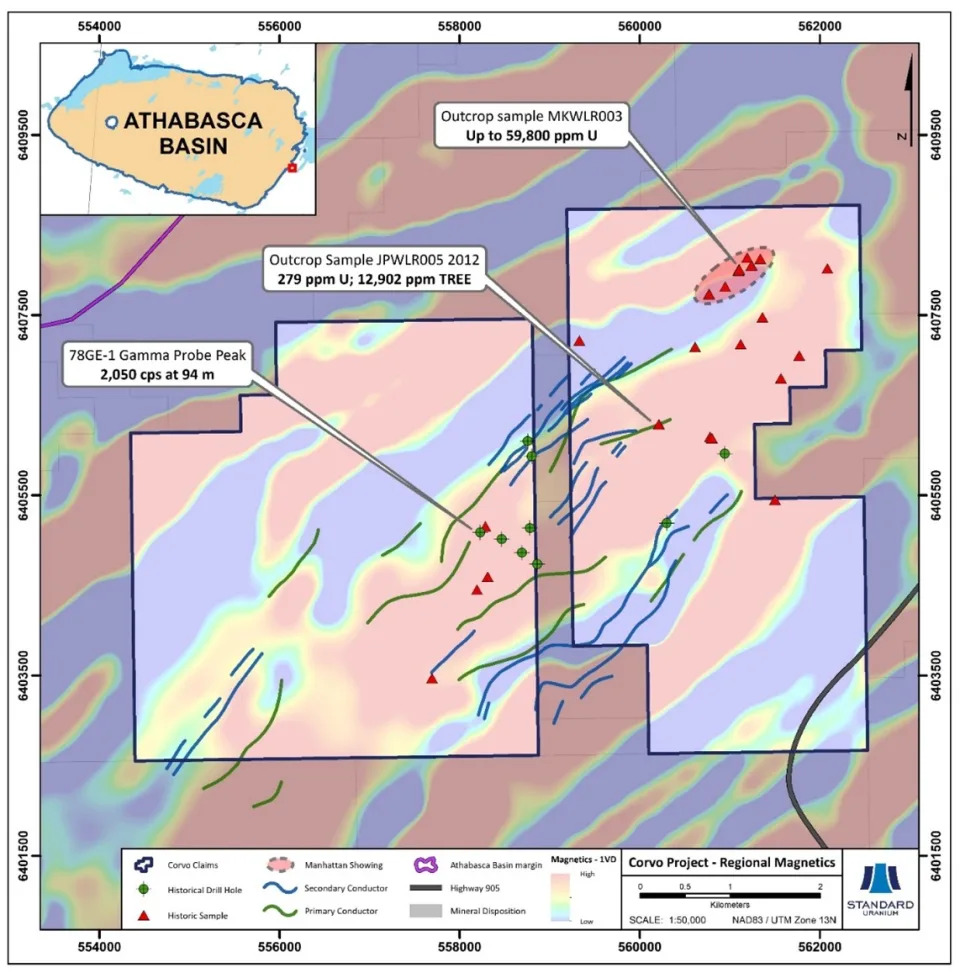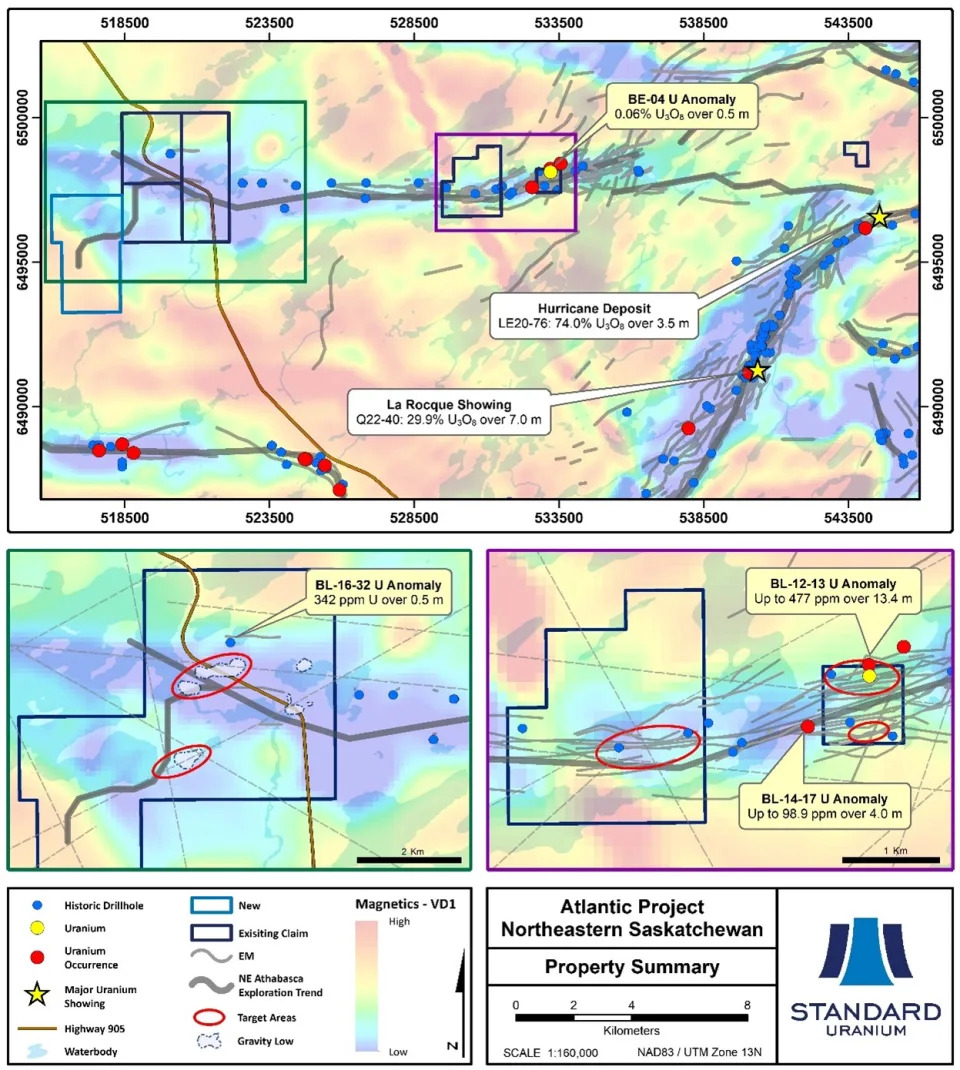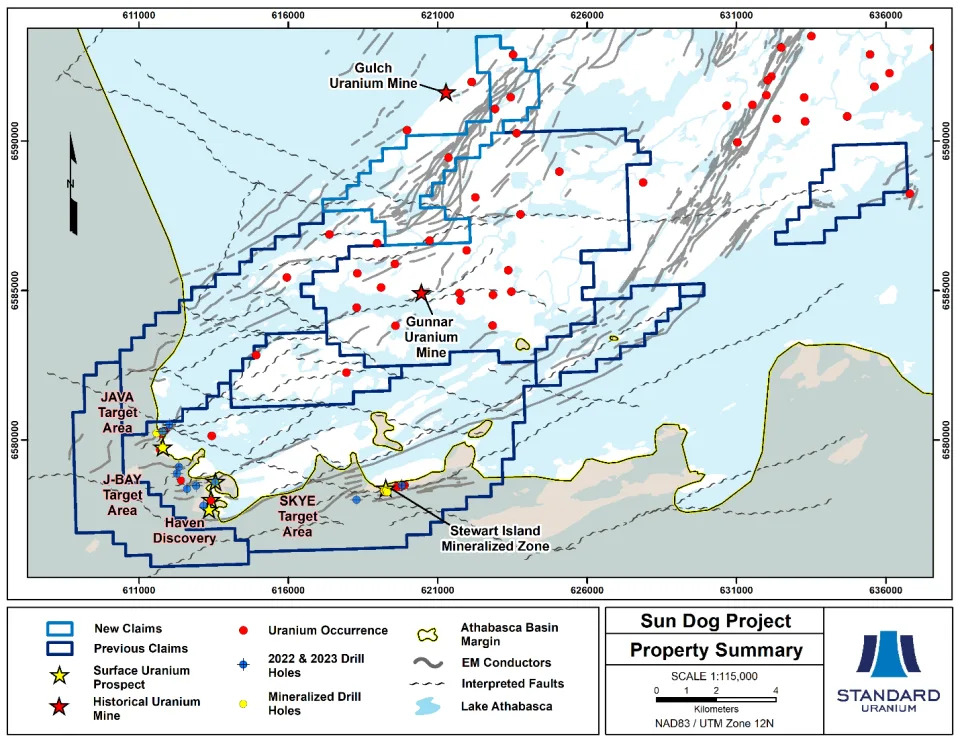Standard Uranium (STND.V) is a junior uranium explorer operating in the Athabasca basin in Saskatchewan, Canada. The Company holds interest in over 176,969 acres (71,617 hectares) there.
Today, Standard Uranium announced the expansion of the 100% owned Sun Dog and Atlantic Projects and the expansion of the Company’s portfolio of highly prospective projects alongside other corporate updates.
Jon Bey, CEO and Chairman for the Company, commented, “This summer has been challenging for many uranium junior exploration companies and investors. I believe we are going to see a much stronger second half of this year and our team has been quietly building our portfolio of projects and working on completing joint venture deals with new partners. I would also like to congratulate Sean Hillacre on his new role, Sean is a valued member of our team, and he will make a great President.”
Standard Uranium has added the Corvo Project to its portfolio through staking. The Company now has ownership interests in seven projects, totaling over 176,969 acres across the uranium-rich Athabasca Basin. The Company is seeking strategic partners to advance the projects through earn-in agreements that provide upside to shareholders through ongoing exploration and future discovery.
The Corvo Project is situated 1.5 kilometres outside the current margin of the Athabasca Basin, approximately 50 kilometres southwest of Rabbit Lake mill facilities and 45 kilometres northeast of the Gemini Mineralized Zone as seen on the image above. Data compilation by the Company is currently underway to identify target areas for high-grade uranium mineralization within metasedimentary and orthogneissic basement rocks. The Project will benefit from additional surface sampling and geophysical surveys to aid in drill target vectoring. The Company believes the Corvo Project is prospective for the discovery of shallow, high-grade basement-hosted uranium mineralization akin to that recently discovered at the Gemini Mineralized Zone.
“As our technical team continues to expand our strategic land holdings in the Basin, the Corvo Project provides another opportunity for the Company to create value for shareholders through exploration of shallow targets for high-grade uranium,” said Sean Hillacre, President and VP Exploration for the Company. “Located just outside the present-day Basin margin along Highway 905, the logistics and geological setting of Corvo are ideal for discovery of an accessible and economic uranium deposit.”
Corvo is host to the previously discovered Manhattan Showing having returned upwards of 59,800 ppm U with elevated Th, Pb, and TREEs and is in the vicinity of SMDI 2052.
Atlantic Project
The Atlantic project consists of 7 mineral dispositions totalling 3,061 hectares, strategically located due west of IsoEnergy’s Hurricane Deposit. The project was acquired via staking in March 2019, and Standard Uranium holds a 100%-interest in the property. Atlantic has recently been expanded by 885 hectares, covering an additional 226 m of magnetic low/EM conductor strike length.
In June 2022, Standard Uranium completed a high-resolution ground gravity survey to identify subsurface density anomalies on the western claim block. The Atlantic Project will require very little additional exploration before drill testing unconformity-related uranium target zones. Exploration efforts are focused on several high-priority target areas along several kilometres of mineralized conductors, coincident with cross-cutting faults and historical zones of elevated uranium in addition to favourable geochemical and geophysical anomalies identified through the current work.
Sun Dog Project
Standard Uranium holds a 100%-interest in the 19,604-hectare Sun Dog project along the northwestern edge of the Athabasca Basin. The Sun Dog project comprises of 9 mineral claims located near Uranium City, and contains the historic Gunnar uranium mine in the Beaverlodge district where uranium was mined between 1953 and 1982. The Sun Dog Project has been expanded by 1,502 hectares, adding an additional 6.75 km of NE-SW trending conductor strike length and additional surface uranium occurrences.
The Company has completed two reconnaissance-scale drill programs on the project totalling 2,469 metres of diamond drilling in the winter of 2022 and 2023. Work to date is highlighted by the first drill hole at the Haven discovery, SD-23-013, which intersected 1.5 m of elevated radioactivity up to 1,300 cps associated with a strong hydrothermal alteration halo. Assay results from the winter 2023 drill program are currently being processed and will be released upon final approval and compilation.
Davidson River Project
This is Standard Uranium’s flagship project and encapsulates the inferred extension of the structural trend that hosts Fission Uranium’s Triple R deposit and NexGen Energy’s Arrow deposit. The project consists of 10 contiguous mineral dispositions totaling 30,737 hectares and lies approximately 25 to 30 km west of Arrow and Triple R, and 75 km south of the past producing Cluff Lake uranium mines.
The Company has completed 16,561 metres of diamond drilling in 39 drill holes on the Davidson River property since 2020, which has identified several zones of elevated uranium and clay-dravite alteration.
Favorable lithologies have been intersected across the four main trends on the property, emphasized by multiple stacked and reactivated graphitic shears and hydrothermal fluid flow on the Bronco trend, as well as a shallow highly prospective limonite-hematite redox alteration zone along the Thunderbird trend.
Additionally, F3 Uranium’s recently discovered high-grade JR Zone (also situated west of the Clearwater Domain), is 20 km northeast of these shear zones and positioned along a conductor parallel to those found on the Davidson River property.
This highlights the potential for the Davidson River property to host significant basement-hosted uranium mineralization and supports the Company’s theory that the uranium fertile conductors which host the Triple R and Arrow deposit are mirrored on the western side of the Clearwater Domain.
The Company believes the 2020-2022 diamond drilling programs have returned encouraging results on the property for uranium exploration in the emerging southwest Athabasca Basin district, and that the property contains several untested priority targets along the four major conductors that warrant further exploration.
Canary Project
The Canary project comprises 2 mineral dispositions totalling 7,303 hectares, located along the Waterfound River in the Athabasca Basin. The project was acquired via staking in July 2020, and Standard Uranium holds a 100%-interest in the property.
Only one of the three conductive targets on the property has been tested by drilling, and results are considered highly anomalous. Historical drill-hole CRK-137 identified highly anomalous uranium enrichment near the unconformity with 10 ppm uranium over 7.4 metres in systematic composite sampling of the sandstone, and strong hydrothermal alteration was observed throughout the interval.
Exploration at the Canary project is in its early stage, and the project remains highly prospective for unconformity-related and basement hosted uranium mineralization. The ground-based DCIP resistivity survey completed by the Company in 2022 revealed several areas of low-resistivity anomalism paired with conductor disruptions, defining high-priority drill targets for an inaugural drill program on the project.
Ascent Project
Standard Uranium holds a 100%-interest in the Ascent project which straddles the eastern boundary of the Athabasca Basin. The project consists of a single mineral disposition totaling 3,737 hectares.
Regional prospecting by historical operators identified uranium enrichment in basement rocks located east of the Athabasca Basin edge, which support the exploration model for shallow sandstone and basement hosted uranium on the property.
The current exploration model for the Ascent project is analogous to that of the J-Zone and Roughrider deposits, that are located proximal to a similar airborne EM target that has dimensions of roughly 2-km long by 1-km wide. The Ascent EM target is interpreted by the Company to represent a shallow-dipping conductive system and will be the focus of future exploration programs, drawing on the analogy of the J-Zone and Roughrider uranium deposits.
Rocas Project
The Rocas project comprises 3 mineral dispositions totalling 3,152 hectares, located 75 kilometers southwest of the Key Lake Mine and Mill facilities along Highway 914, and approximately 72 kilometers south of the present-day margin of the Athabasca Basin. The project was acquired via staking in May 2023, and Standard Uranium holds a 100%-interest in the property.
The Project covers 5.5 kilometres of a northeast trending magnetic low/electromagnetic (EM) conductor corridor which hosts several uranium anomalies, including historical mineralized outcrop grab samples along approximately 900 metres of strike length, grading up to 0.50 wt. % U3O8. Notably, none of the historical uranium occurrences have been drill-tested. Data compilation by the Company has identified multiple target areas for shallow high-grade basement-hosted uranium mineralization within metasedimentary and orthogneissic basement rocks. The Project will benefit from additional surface sampling and geophysical surveys to aid in drill target vectoring.

At time of writing, the stock is up over 20% on the day.
A major support was broken back in Spring 2023 when the stock closed below $0.06. The downtrend continued until we hit all time record lows at $0.02. Now, the stock is ranging, and today’s news has caused a gap up pop testing key resistance. A close above $0.035 would be a strong indicator that the trend is shifting. Not only would we have a range breakout, but also a close above the previous lower high resulting in the end of the current downtrend.

